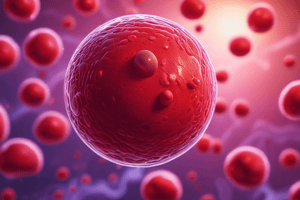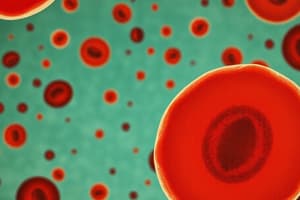Podcast
Questions and Answers
What infection commonly causes swelling of lymph nodes in the neck?
What infection commonly causes swelling of lymph nodes in the neck?
Lung cancer can spread to lymph nodes in the abdomen.
Lung cancer can spread to lymph nodes in the abdomen.
False
Name one type of cancer that can cause lymph node swelling in the neck.
Name one type of cancer that can cause lymph node swelling in the neck.
Throat cancer
Infection of _____ organs can cause swelling of lymph nodes in the groin.
Infection of _____ organs can cause swelling of lymph nodes in the groin.
Signup and view all the answers
Match the type of cancer to the location where it spreads to lymph nodes:
Match the type of cancer to the location where it spreads to lymph nodes:
Signup and view all the answers
Which viral infection is known for causing lymph node swelling in various parts of the body?
Which viral infection is known for causing lymph node swelling in various parts of the body?
Signup and view all the answers
Tonsils are located only in the throat region.
Tonsils are located only in the throat region.
Signup and view all the answers
What are the clusters of lymphatic tissue located just under the mucous membranes in the throat called?
What are the clusters of lymphatic tissue located just under the mucous membranes in the throat called?
Signup and view all the answers
______(cancer of lymphatic system) can cause swelling in many lymph nodes.
______(cancer of lymphatic system) can cause swelling in many lymph nodes.
Signup and view all the answers
What term describes blood cell production occurring outside the bone marrow?
What term describes blood cell production occurring outside the bone marrow?
Signup and view all the answers
Hematopoiesis is the process of forming blood cells in adults only.
Hematopoiesis is the process of forming blood cells in adults only.
Signup and view all the answers
What are the two types of progenitor cells that HSCs differentiate into?
What are the two types of progenitor cells that HSCs differentiate into?
Signup and view all the answers
In the third month of intrauterine life, the main organ producing RBCs is the _______.
In the third month of intrauterine life, the main organ producing RBCs is the _______.
Signup and view all the answers
Match the following stages of erythropoiesis with their characteristics:
Match the following stages of erythropoiesis with their characteristics:
Signup and view all the answers
Which cells do common lymphoid progenitors (CLP) produce?
Which cells do common lymphoid progenitors (CLP) produce?
Signup and view all the answers
In newborn babies, RBCs are produced from multiple sites, including the liver and spleen.
In newborn babies, RBCs are produced from multiple sites, including the liver and spleen.
Signup and view all the answers
During the last trimester of fetal life, RBC production occurs primarily in the _______.
During the last trimester of fetal life, RBC production occurs primarily in the _______.
Signup and view all the answers
What is the primary site for producing red blood cells after the age of 20?
What is the primary site for producing red blood cells after the age of 20?
Signup and view all the answers
The shaft of long bones continues to produce red blood cells throughout adulthood.
The shaft of long bones continues to produce red blood cells throughout adulthood.
Signup and view all the answers
What is the hormone called that is crucial for erythropoiesis?
What is the hormone called that is crucial for erythropoiesis?
Signup and view all the answers
The _______ are considered the major producing sites for blood cells in adults if bone marrow is not functional.
The _______ are considered the major producing sites for blood cells in adults if bone marrow is not functional.
Signup and view all the answers
Match the stages of erythropoiesis with their characteristics:
Match the stages of erythropoiesis with their characteristics:
Signup and view all the answers
Which of the following stages of erythropoiesis involves the cessation of cell division?
Which of the following stages of erythropoiesis involves the cessation of cell division?
Signup and view all the answers
At the reticulocyte stage, the cell has extruded its nucleus.
At the reticulocyte stage, the cell has extruded its nucleus.
Signup and view all the answers
What percentage of the bone marrow is involved in producing erythrocytes?
What percentage of the bone marrow is involved in producing erythrocytes?
Signup and view all the answers
What is the primary role of vitamin B12 in the body?
What is the primary role of vitamin B12 in the body?
Signup and view all the answers
A deficiency of vitamin B12 can lead to macrocytic anemia.
A deficiency of vitamin B12 can lead to macrocytic anemia.
Signup and view all the answers
What is produced by the parietal cells of the gastric glands?
What is produced by the parietal cells of the gastric glands?
Signup and view all the answers
Deficiency of intrinsic factor leads to __________ anemia.
Deficiency of intrinsic factor leads to __________ anemia.
Signup and view all the answers
Which of the following is NOT a necessary factor for hemoglobin formation?
Which of the following is NOT a necessary factor for hemoglobin formation?
Signup and view all the answers
Match the following vitamins with their roles in hemoglobin formation:
Match the following vitamins with their roles in hemoglobin formation:
Signup and view all the answers
What type of anemia results from folic acid deficiency?
What type of anemia results from folic acid deficiency?
Signup and view all the answers
Copper is necessary for the utilization of iron during hemoglobin formation.
Copper is necessary for the utilization of iron during hemoglobin formation.
Signup and view all the answers
What are lymphatic organs primarily composed of?
What are lymphatic organs primarily composed of?
Signup and view all the answers
Lymph nodes are present in the central nervous system.
Lymph nodes are present in the central nervous system.
Signup and view all the answers
Name three areas in the body where lymph nodes tend to cluster.
Name three areas in the body where lymph nodes tend to cluster.
Signup and view all the answers
Lymph nodes filter lymph before it is returned to the ______.
Lymph nodes filter lymph before it is returned to the ______.
Signup and view all the answers
Match the following lymphatic organs with their functions:
Match the following lymphatic organs with their functions:
Signup and view all the answers
What typically causes swelling of lymph nodes?
What typically causes swelling of lymph nodes?
Signup and view all the answers
Lymph nodes will gradually restore to their original size after recovery from infection.
Lymph nodes will gradually restore to their original size after recovery from infection.
Signup and view all the answers
Lymph moves through the lymph sinuses and enters an efferent lymphatic vessel at the ______.
Lymph moves through the lymph sinuses and enters an efferent lymphatic vessel at the ______.
Signup and view all the answers
What are enlarged tonsils referred to as when they interfere with breathing?
What are enlarged tonsils referred to as when they interfere with breathing?
Signup and view all the answers
The spleen is the smallest lymphatic organ in the body.
The spleen is the smallest lymphatic organ in the body.
Signup and view all the answers
What two types of tissue does the spleen consist of?
What two types of tissue does the spleen consist of?
Signup and view all the answers
The thymus is located __________ to the ascending aorta.
The thymus is located __________ to the ascending aorta.
Signup and view all the answers
Match the following organs with their primary functions:
Match the following organs with their primary functions:
Signup and view all the answers
Which of the following cells in the spleen react to pathogens in the blood?
Which of the following cells in the spleen react to pathogens in the blood?
Signup and view all the answers
The thymus increases in size after puberty.
The thymus increases in size after puberty.
Signup and view all the answers
What happens to blood in the spleen during emergencies such as hemorrhage?
What happens to blood in the spleen during emergencies such as hemorrhage?
Signup and view all the answers
Study Notes
Red Blood Cell (Erythrocytes) Structure and Function
- Red blood cells (RBCs) transport gases and nutrients
- Hemoglobin is a protein that attaches to oxygen and carries it to tissues
- Normal RBC concentrations: 3.9-5.5 million/µL in women and 4.1-6 million/µL in men
- RBCs are red due to hemoglobin (iron-containing pigment)
- RBCs are formed in bone marrow (ends of long, flat, and irregular bones)
RBC Structure
- Biconcave shape (thin center, thicker rim)
- Lack nuclei and mitochondria, allowing for more hemoglobin
- Measures approximately 7.5 µm in diameter, 2.6 µm thick at the rim, and 0.8 µm thick at the center
- Flexible membrane for movement through capillaries
RBC Membrane and Cytoskeleton
- Composed of proteins and lipids for structural integrity and flexibility
- Cytoskeleton (actin, spectrin, band 3, protein 4.1, ankyrin) maintains shape and flexibility
Hemoglobin
- Hemoglobin accounts for approximately 270 hemoglobin molecules per RBC
- Hemoglobin is a complex protein (globin and iron-containing heme), produced in developing RBCs
- Binds with oxygen to create oxyhemoglobin (red blood color).
- Critical for carbon dioxide transport from body cells to the lungs
RBC Life Cycle
- Production: Primarily in bone marrow from hematopoietic stem cells (HSCs)
- Maturation: process involves expulsion of nucleus, loss of organelles, and formation of biconcave shape
- Destruction: Mature RBCs live approximately 120 days and are removed by macrophages in the spleen and liver
RBC Functions
- Primary role is respiratory gas transport
- Oxygen transport: Hemoglobin and oxyhemoglobin (97%) transport oxygen
- Carbon dioxide transport: Hemoglobin transports a portion of CO2 and carbonic anhydrase plays a critical role
- Buffering: Hemoglobin helps regulate hydrogen ion concentration (pH balance)
- Blood group determination: RBCs carry blood group antigens (A, B, and Rh factor)
Hematopoiesis
- Continuous process of blood cell production, including renewal, proliferation, differentiation, and maturation
- Primary locations change throughout life (fetal development, bone marrow)
- Hematopoietic stem cells (HSCs): most primitive blood cells, capable of self-renewal and pluripotency. These cells differentiate into more mature cells including common lymphoid progenitor (CLP) and common myeloid progenitor (CMP)
Factors Necessary for Erythropoiesis
- General factors: Erythropoietin (hormone), thyroxine, hemopoietic growth factors, and vitamins
- Maturation factors: Vitamin B12, intrinsic factor, and folic acid
- Factors for Hemoglobin Formation: Iron, copper, cobalt, and certain vitamins
The Lymphatic System
- Consists of fluid (lymph), vessels, and organs containing lymphoid tissue.
- Lymph: fluid similar to blood plasma, but with a lower protein content.
- Lymph vessels collect interstitial fluid and return it to the blood.
- Lymph nodes: small bean-shaped structures that filter lymph.
- Spleen, thymus, tonsils: also part of the lymphatic system
- Spleen filters blood, removing old or damaged red blood cells.
Causes of Swollen Lymph Nodes
- Infection (skin, throat, genital, viral), some types of cancer (throat, lung, breast, lymphomas/leukemia).
Studying That Suits You
Use AI to generate personalized quizzes and flashcards to suit your learning preferences.
Related Documents
Description
Test your knowledge on the structure and function of red blood cells (RBCs). This quiz covers topics such as hemoglobin, RBC formation, and the unique properties of these vital cells. Dive into the world of erythrocytes and learn how they transport oxygen and maintain health.




